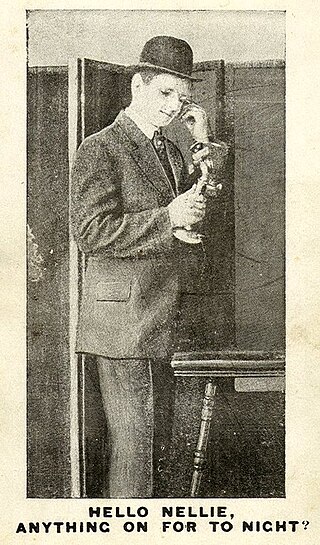Grok is a neologism coined by American writer Robert A. Heinlein for his 1961 science fiction novel Stranger in a Strange Land. While the Oxford English Dictionary summarizes the meaning of grok as "to understand intuitively or by empathy, to establish rapport with" and "to empathize or communicate sympathetically (with); also, to experience enjoyment", Heinlein's concept is far more nuanced, with critic Istvan Csicsery-Ronay Jr. observing that "the book's major theme can be seen as an extended definition of the term." The concept of grok garnered significant critical scrutiny in the years after the book's initial publication. The term and aspects of the underlying concept have become part of communities such as computer science.

A metaphor is a figure of speech that, for rhetorical effect, directly refers to one thing by mentioning another. It may provide clarity or identify hidden similarities between two different ideas. Metaphors are usually meant to create a likeness or an analogy.
Mise-en-scène is the stage design and arrangement of actors in scenes for a theatre or film production, both in the visual arts through storyboarding, visual themes, and cinematography and in narrative-storytelling through directions. The term is also commonly used to refer to single scenes that are representative of a film.
Jargon or technical language is the specialized terminology associated with a particular field or area of activity. Jargon is normally employed in a particular communicative context and may not be well understood outside that context. The context is usually a particular occupation, but any ingroup can have jargon. The key characteristic that distinguishes jargon from the rest of a language is its specialized vocabulary, which includes terms and definitions of words that are unique to the context, and terms used in a narrower and more exact sense than when used in colloquial language. This can lead outgroups to misunderstand communication attempts. Jargon is sometimes understood as a form of technical slang and then distinguished from the official terminology used in a particular field of activity.

A circular definition is a type of definition that uses the term(s) being defined as part of the description or assumes that the term(s) being described are already known. There are several kinds of circular definition, and several ways of characterising the term: pragmatic, lexicographic and linguistic. Circular definitions are related to Circular reasoning in that they both involve a self-referential approach.
A moral is a message that is conveyed or a lesson to be learned from a story or event. The moral may be left to the hearer, reader, or viewer to determine for themselves, or may be explicitly encapsulated in a maxim. A moral is a lesson in a story or in real life.

A double entendre is a figure of speech or a particular way of wording that is devised to have a double meaning, one of which is typically obvious, and the other often conveys a message that would be too socially unacceptable, or offensive to state directly.
Literal and figurative language is a distinction within some fields of language analysis, in particular stylistics, rhetoric, and semantics.
An in-joke, also known as an inside joke or a private joke, is a joke with humour that is understandable only to members of an ingroup; that is, people who are in a particular social group, occupation, or other community of shared interest. It is, therefore, an esoteric joke, only humorous to those who are aware of the circumstances behind it.

A narrative, story, or tale is any account of a series of related events or experiences, whether nonfictional or fictional. Narratives can be presented through a sequence of written or spoken words, through still or moving images, or through any combination of these. The word derives from the Latin verb narrare, which is derived from the adjective gnarus. The formal and literary process of constructing a narrative—narration—is one of the four traditional rhetorical modes of discourse, along with argumentation, description, and exposition. This is a somewhat distinct usage from narration in the narrower sense of a commentary used to convey a story. Many additional narrative techniques, particularly literary ones, are used to build and enhance any given story.
Deaf-mute is a term which was used historically to identify a person who was either deaf and used sign language or both deaf and could not speak. The term continues to be used to refer to deaf people who cannot speak an oral language or have some degree of speaking ability, but choose not to speak because of the negative or unwanted attention atypical voices sometimes attract. Such people communicate using sign language. Some consider it to be a derogatory term if used outside its historical context; the preferred term today is simply deaf.

A wink is a facial expression made by briefly closing one eye. A wink is an informal mode of non-verbal communication usually signaling shared hidden knowledge or intent. However, it is ambiguous by itself and highly dependent upon additional context, without which a wink could become misinterpreted or even nonsensical. For example, in some regions of the world, a wink may be considered rude or offensive. Depending on the relationship of the people involved, a wink could possibly constitute a sexual gesture.
Pro re nata is a Latin phrase meaning "in the circumstances" or "as the circumstance arises". In medical terminology, it is often abbreviated PRN or P.R.N. and refers to the administration of prescribed medication as the situation calls for it.

Relevance theory is a framework for understanding the interpretation of utterances. It was first proposed by Dan Sperber and Deirdre Wilson, and is used within cognitive linguistics and pragmatics. The theory was originally inspired by the work of Paul Grice and developed out of his ideas, but has since become a pragmatic framework in its own right. The seminal book, Relevance, was first published in 1986 and revised in 1995.
Exformation is a term first coined by Danish science writer Tor Nørretranders in his book The User Illusion. Published in English 1998, the book was intended to conceptualize the definition as explicitly discarded information.

Hello is a salutation or greeting in the English language. It is first attested in writing from 1826.

A literary trope is the use of figurative language, via word, phrase or an image, for artistic effect such as using a figure of speech. Keith and Lundburg describe a trope as "a substitution of a word or phrase by a less literal word or phrase". The word trope has also undergone a semantic change and now also describes commonly recurring or overused literary and rhetorical devices, motifs or clichés in creative works. Literary tropes span almost every category of writing, such as poetry, film, plays, and video games.
A Scotticism is a phrase or word, used in English, which is characteristic of Scots.

Bling-bling, often shortened to just bling, is "flashy jewelry worn especially as an indication of wealth or status; broadly: expensive and ostentatious possessions" such as grills and designer bags. The term arose as slang, but grew into a cultural mainstay. Prominent examples of bling-bling include a large cross necklace or Jesus piece.
Explicature is a technical term in pragmatics, the branch of linguistics that concerns the meaning given to an utterance by its context. The explicatures of a sentence are what is explicitly said, often supplemented with contextual information. They contrast with implicatures, the information that the speaker conveys without actually stating it.








